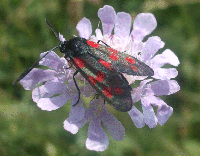When to Watch Wildlife | J | F | M | A | M | J | J | A | S | O | N | D | Search |
Current wildlife highlights | ||
| What's new on this site | ||
| Wildlife calendar | ||
|
Plants and Animals | ||
| Habitats | ||
| Wildlife sites | ||
| WWW links | ||
|
Guide Books | ||
| ||
© PMcS 2006 |
Putting up nest boxes |
| Go to the main birds page. In gardens there is generally a shortage of nest sites for many bird species. Tits, robins, starlings, tawny owls, tree creepers, spotted fly catchers can all be encouraged to nest in your garden if they are provided with the right types of boxes. Some birds such as house sparrows and house martins actually need the nest box to be mounted on a building, often a house. If you wish you can also provide boxes that will attract bats and bees. The birds listed above require different holes sizes and shapes and require boxes of different box sizes. The BTCV has fully described the positioning and sizes of each type of nest box for each type of bird on their web site. House martins require special types of boxes and if you are happy to accommodate them can provide lots of interest. These can be purchased from specialist suppliers. For other species visit the Cornwall Wildlife Trust site which has advice on how to build a variety of boxes. Of course you can buy most of these if you search the web or visit good pet shops. The RSPB recommends the following: 'Put your box in a quiet place out of the reach of cats, generally between two and five metres up a tree, fence or wall. Try to face it between north and east, as this avoids strong sunlight and the wettest winds. Tilt the box forward slightly so that driving rain hits the roof and does not enter the box. Put different types of box in different places around the garden. For instance, put open-fronted nestboxes low down and hide them well in vegetation to attract robins and wrens. It is important to clean out your nestboxes during the winter every year. This will prevent a build up of debris and remove parasites such as fleas. If you put in a handful of clean hay or wood shavings, birds may use it as a winter roost.' Whatever you decide do try to provide a helping hand to our breeding birds.
|
|
All images and text are copyright PMcS 2006
